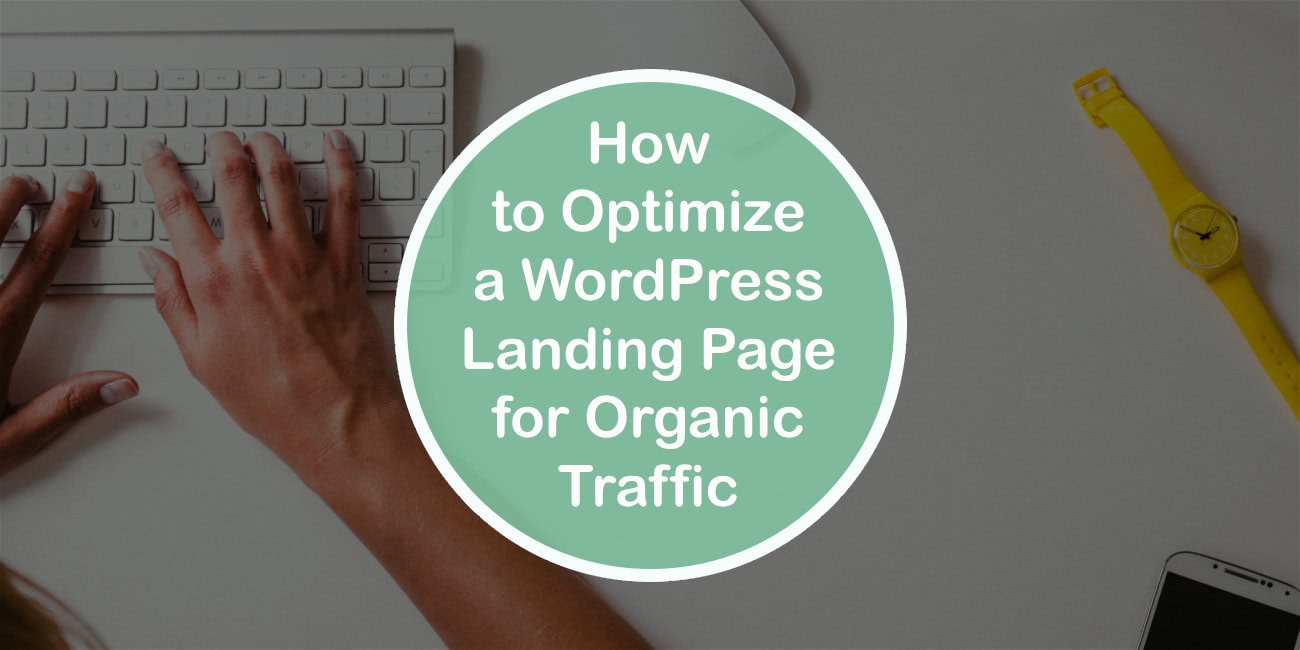Your WordPress landing page is the first point of contact between your business and visitors. If it’s optimized and impressive, it will lead to business success.
In most cases, implementing best practices such as engaging visuals, clear headlines, mobile optimization, and strong calls to action will get you good to go. However, you should be ready to make changes based on the insights you gain into visitor behavior and preferences.
This brings us to our next point: tracking all your optimization efforts to make data-driven decisions. And that’s when it becomes necessary to invest in well-rounded SEO software.
Thankfully, you can find quite a few of them, and it’s also possible to find the best alternatives to popular SEO services to get more value for money. Be sure to compare those software solutions and SEO platforms on review sites before you pick one.

Understanding Organic Traffic
Organic traffic is visitors from search engines through unpaid, natural search results. Organic traffic relies heavily on the quality and relevance of a website’s content and its ability to rank in SERPs.
Data shows that more than half of all website visits come from organic search. If you rank higher in organic search, you will notice a significant boost in your site’s credibility, increasing engagement and conversions.
How Search Engines Prioritize Organic Results?
Good landing page optimization is essential. It helps search engine algorithms, like those used by Google, identify pages with vital ranking factors. These are the pages search engines prioritize for ranking in organic searches.
The key ranking factors include:
- the relevance of the title, headings, content, and metadata to the search inquiry
- the quality of the content and its usefulness to user intent
- website speed, mobile-first preparedness, and the quality of the user experience
- backlinks from reputable sites
- the engagement metrics, including time on page (TOP) and bounce rate (BR)
Google frequently updates its algorithms but always focuses on encouraging people-first content. This emphasis makes it vital to keep every WordPress landing page up to date with the best optimization.
Benefits of Organic Traffic versus Paid Traffic
In the short term, paid ads boost traffic, but it’s concentrating SEO efforts on organic searches that benefit you in the long term. It has several other clear advantages, such as:
- cost-effectiveness
- sustainability
- credibility
- relevance
- competitiveness
Users trust search engine results more than paid ads, so high organic rankings drive more traffic.
2. Choosing the Right WordPress Theme
Choosing a theme that will generate organic traffic requires careful consideration. A number of essentials, including mobile-friendliness and responsiveness, have implications for the user experience and SEO.
The key factors to consider when deciding a theme are:
- Page speeds: Some design features slow performance, which can be assessed using Google PageSpeed Insights.
- Mobile-friendliness: Google uses mobile-first indexing. Since over two-thirds of online purchases are made from mobiles, pages must perform well across various devices.
- Clean code: Well-structured HTML coding eases crawling and indexing, making it essential to use the correct semantics.
- Compatibility with SEO plugins: The theme must integrate seamlessly with popular plugins like Yoast SEO. Such plugins are helpful; however, it’s just as essential that the theme doesn’t require too many to be functional.
- Customization Options: Customization helps workflow, but it’s best to consider themes that don’t require changes to their code. A highly customizable theme that needs no further input from the developer is perhaps the most useful.
Here are some standout WordPress themes in 2023 that you may want to consider:
- Astra – a popular choice for its speed and customization options
- Generate Press – famous for prioritizing clean code and fast-loading
- Neve – designed with attention to SEO, Neve offers responsive layouts and compatibility with a range of plugins
3. Optimizing On-Page Elements

Optimizing the on-page elements such as title tags, meta descriptions, and URLs efficiently will drive traffic to your landing page. It is a strategy that significantly improves rankings and CTRs.
Here’s what you should remember when optimizing your WordPress landing page:
i. Title tags
Title tags should:
- include the primary keyword near the beginning
- be under 60 characters long
- be compelling and click-worthy
ii. Meta descriptions
These should be under 160 characters.
Meta descriptions:
- summarize the topic and value proposition of the page
- incorporate the primary keywords naturally, as in speech
- use the passive voice except in call-to-action prompts to encourage clicks
iii. URLs
Clean, well-organized URLs act as concise descriptions of the page’s content and encourage click-throughs.
For effective URLS:
- include the primary keyword
- use hyphens, not underscores
- do not include parameters or numbers
Besides paying attention to meta-tags and titles, you also need to focus on writing compelling, keyword-rich content. This type of content is regarded as high-quality and is a better match with user intent, making it more likely to provide value for users.
High-quality, keyword-rich content:
- focuses on being well-researched, original and in-depth
- incorporates the primary keywords and their synonyms naturally
- has a clear structure optimized by headings and subheadings with short paragraphing and brief bullet points for high readability
- optimized images with alt text and descriptive file names
- encourages prolonged engagement by including internal links to relevant pages
Be sure to pay special attention to using headings and subheadings when optimizing page content. Headings (H1-H6) provide structure and signal the hierarchy of the content. They enhance the user experience by making it easier for search engines and users to navigate the site.
Typical best practices for using headings effectively include:
- using only one H1 tag per page
- using headings logically to break the content into sections
- the natural use of relevant keywords
4. Utilizing SEO Plugins for Better Optimization and Tracking

A good thing about being on WordPress is that you can utilize several impressive SEO plugins. They help you optimize various on-page elements in no time and offer additional tools to monitor your campaign.
If you’re looking for a plugin to start with, Yoast SEO is an excellent option. It has been around for a long time and is known for its simple interface and useful SEO features. While you can perform quite a few tasks using the free version, you may have to upgrade to a premium plan for additional options like content insights, linking suggestions, and redirect management.
On the other hand, Rank Math is fast becoming a popular alternative to Yoast SEO. It comes with extensive features, even when you decide to use the free version. Most people like it for its simple setup wizard, advanced content analysis, built-in schema markup, and various other SEO features. You can use it to set a focus keyword for your posts and also easily optimize meta titles and descriptions.
Again, adding schema markup is an important task for SEO, and both plugins can do it for you. However, where Yoast SEO only adds some schema markup in the background, Rank Math helps add it more professionally to products, articles, recipes, etc., which improves your rich snippet potential in SERPs.
However, when it comes to content analysis, both plugins work efficiently to assess on-page elements, such as readability, keyword density, image alt text, internal and external links, and text length.
Moreover, they offer additional tools to monitor your SEO performance. Rank Math readily integrates with Search Console and Google Analytics for keyword rank tracking. Yoast SEO can do the same and shows you your site’s indexing status, crawl errors, and other performance indicators.
5. Improving Page Speed
Fast page speed is a critical component of SEO for WordPress website users. This key ranking feature enhances user engagement. Quick load times prolong TOP, lower BR, and increase conversions.
In its 2023 Core Web Vitals update, Google clarified what its search engine is primed to prioritize. Page speed, site performance, interactivity, and visual stability are featured. The update provided a holistic perspective on how poor load times impact the user experience and, ultimately, the bottom line.
If you’re interested in improving page speed, you need to keep the following tips in mind.
Optimize Images
Good-quality images are essential. They enhance written content but files tend to be large. Using them often means compromising site performance.
To use large images without impacting performance:
- resize and crop images to fit
- compress files using tools like Photoshop
- use next-gen formats like WebP for better compression
- use lazy loading
- use a CDN to serve images from closer to the user
Plugins like Optimole are valuable tools that automate the image optimization process.
Minify CSS and JavaScript (JS)
Removing unnecessary characters and scripts automatically using WP Super Minify helps improve load times. As does combining multiple CSS and JS files and removing unused ones.
Leverage Browser Caching
Browser caching, storing frequently used files on the user’s browser, means they don’t have to be downloaded. The practice frees up processing power and increases load times for returning visitors.
To leverage browser caching:
- use plugins like W3 Total Cache for easy management
- set expiration headers on images, CSS, and JS
- implement entity tags (ET Tags)
What’s more, you can also try some other additional optimization options. For instance:
- Enable GZIP compression for file transfers
- Limit the use of plugins and external scripts
- Optimize themes to be lightweight
- Use servers optimized for WordPress
Conclusion
Good optimization improves a landing page’s visibility to the search engines and the users. Thorough optimization is, therefore, an SEO essential that ensures good performance, page load speed, and easy navigation. It also allows for compelling content that includes high-quality visuals and drives organic traffic, especially from Google. Be sure to use the right software solutions to monitor how different SEO tactics work to tweak your strategies and get the best results.

